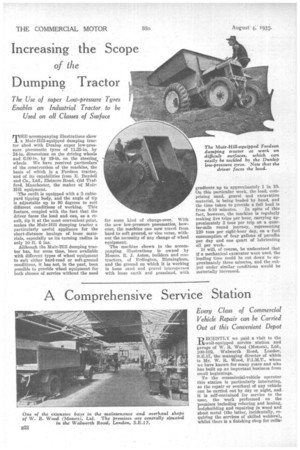Increasing the Scope
Page 32

If you've noticed an error in this article please click here to report it so we can fix it.
of the
Dumping Tractor
The Use of super Low-pressure Tyres Enables an Industrial Tractor to be Used on all Classes of Surface
T" accompanying illustrations show a Muir-Hill-equipped dumping tractor shod with Dunlop super low-pressure pneumatic tyres of 11.25-in. by 24-in. dimensions on the driving wheels and 6.00-in. by 19-in, on the steering wheels. We have received particulars of the construction of the machine, the basis of which is a Fordson tractor, and a its capabilities from E. Boydell and Co., Ltd., Elsinore Road, Old Trafford, Manchester, the maker of MuirHill equipment.
The outfit is equipped with a 2 cubicyard tipping body, and the angle of tip is adjustable up to 90 degrees to suit different conditions of working. This feature, coupled with the fact that the driver faces the load and can, as a result, tip it at the most convenient point, makes the Muir-Hill dumping tractor a particularly useful appliance for the short-distance haulage of loose materials, especially as its turning radius is only 10 ft. 6 ins.
Although the Muir-Hill dumping tractor has, for some time, been available with different types of wheel equipment to suit either hard-road or soft-ground conditions, it has not, in the past, been possible to provide wheel equipment for both classes of service without the need for some kind of change-over. With the new low-pressure pneumatics, however, the machine can now travel from hard to soft ground, or vice versa, without the necessity of any change of wheel equipment.
The machine shown in the accompanying illustrations is owned by Messrs. R. J. Aston, builders and contractors, of Erdington, Birmingham, and the ground on which it is working is loose sand and gravel interspersed with loose earth and grassland, with gradients up to approximately 1 in 10. On this particular work, the load, comprising sand, gravel and excavation material, is being loaded by hand, and the time taken to provide a full load is from 8-10 minutes. In spite of this fact, however, the machine is regularly making five trips per hour, carrying approximately 3 tons per trip on a quarter-mile round journey, representing 120 tons per eight-hour day, on a fuel consumption of four gallons of paraffin per day and one quart of lubricating oil per week. It will, of course, be understood that if a mechanical excavator were used, the loading time could be cut down to approximately three minutes, and the output under similar conditions would be materially increased.




















































































